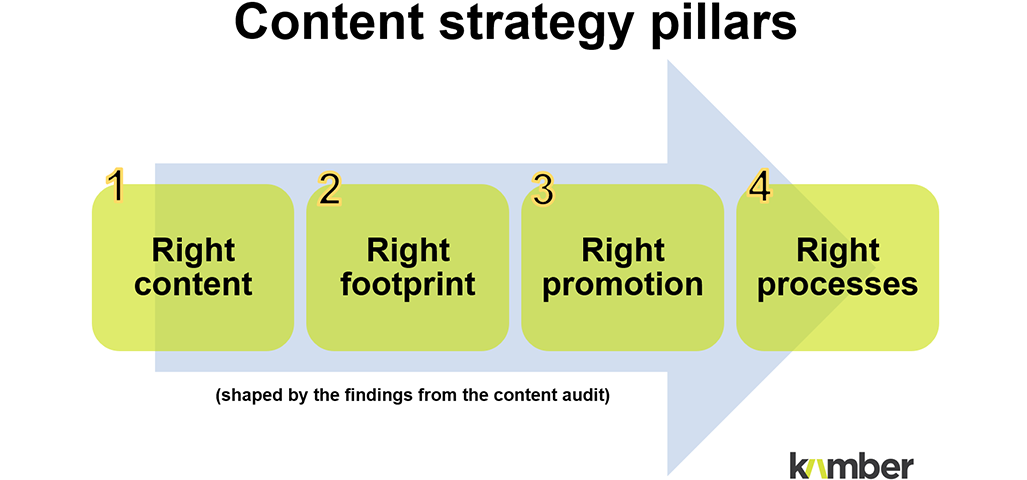SEO Framework for Editorial Content

The key elements to a successful SEO framework for editorial content
Developing the right content strategy paves the way for SEO activity to deliver maximum impact. The chart below summarises our content strategy approach:
SEO strategy development largely falls into step three of the process – Right promotion – but it needs to be considered throughout as well.
Assuming the master SEO strategy has been completed (featuring keywords and guidelines for use), the next step involves activating a framework for on page optimisation.
For brands hoping to progress from active to the maturing phase of the content marketing lifecycle, a content marketing strategy must include and be integrated with an SEO keyword strategy.
Editorial guidance for on page optimisation informs best practise and ensures that content has the best chance of being discovered in search engines and therefore driving organic traffic to your website.
Best practises before writing your content
You should look to ask yourself the following questions before writing your content:
- Page goal
What is the goal of this page – what are you ultimately trying to get your audience to do? - Page audience
Which audience segment is this page targeting? - Key messages
What are the primary key messages that you want to communicate? Consider keeping this to just three.
- Key phrases
What are the keywords and phrases that you need to include for SEO (as outlined within your SEO strategy)?
Best practises during writing the content (on page optimisation)
- Page Headline / Title. This is your <h1>.
Is it clear and catchy, include primary keyword/phrase at the start, if possible. Between 40-70 characters is optimum)?
- First paragraph
What is the one key thing you want your reader to understand once they have read the first paragraph? This should be captured in the first couple of sentences followed by a summary of supporting points throughout the remainder of the page.
- Bolded Sub-Headline. This is your <h2>.
Can I summarise the first main point discussed in the following paragraph, and included keyword/phrase if possible? Then look to back up your main message with a supporting point. You may wish to use bullet points to focus on special features or list further considerations.
- Bolded Sub-Headline. Use another <h2>.
How do I outline the second key point/message in the paragraph below? This should include a keyword where possible. As before, back up your second key point with bullets, a list or maybe even steps to be taken to action this point.
- Bolded Sub-Headline. The third and final time you’ll use a <h2>.
How do I outline the third main point discussed in the next paragraph? Of course include a keyword. Back this up with a supporting point.
- Bolded, Linked Call-to-Action Line
Have I provoked the reader with clear direction on what you want them to do next? Is it to download something from your page, click through to e-commerce, or visit a partner website?
Best practises for SEO and images
Images must add visual context to the copy you’ve written. It’s best to select these after you’ve written your copy.
- Alt tags
Have I used an appropriate and descriptive Alt tag? Alt tags should be used (for those visually impaired) and include agreed SEO keywords e.g. “steak recipe image for mushroom sauce recipe page”. Explain what the image is for and what page it’s on.
- Image size
Is the image the right size? Image can heavily impact site loading times. The faster the site, the easier it is for someone to visit and of course for Google to index. If you have a large image but you’re only displaying it at 200 x 100 pixels, you should consider reducing the resolution. ImageOptim is a great source for this.
Ask yourself the following when reviewing your completed content:
- Is the page content 300 to 500 words?
- Is the headline clear, punchy and catchy?
- Does the keyword appear in the first paragraph of the copy?
- Does the post include any outbound links?
- Have you used short sentences and paragraphs and broken up paragraphs with sub headlines?
- Is this piece of content relevant to your target audience/segment? Does it address at least one of their problems and inspire them to take acrion?
- Have you stated your main point in the first couple sentences – this helps you set the tone throughout?
- Is your content low on industry jargon and easy to read?
- Is there a clear call to action?
- Final keyword check:
-Is there an article heading?
-Is there a page title? - Does the URL include page keyword and URL isn’t too long and free of underscores?
- Meta descriptions present?
- Does the page include relevant tags?
Ultimately, does the content pass the ‘so what’ test? Does it provide value to the reader? If not, you should consider revisiting.
Remember, Google rewards websites for treating people as humans rather than cramming the pages with relevant keywords, so endeavour to get the balance right.
